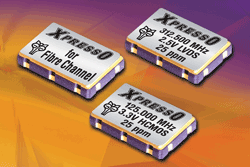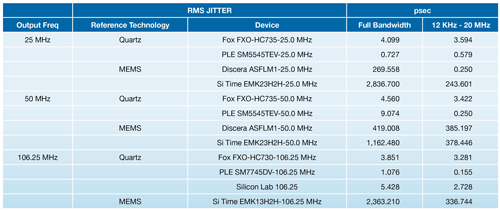There’s more than one route to satisfying demands for accurate timing in electronic devices
BY GENE TREFETHEN, CEO
Fox Electronics
www.foxonline.com
Quartz-based timing technology, which started with fixed-frequency devices using quartz references and simple oscillator electronics, has been revolutionized into new designs. These latest solutions combine a quartz reference plus very sophisticated ASICs in a single package to deliver the ideal custom engineered frequency in just weeks.
And new silicon-based MEMS (micro-electronic mechanical system) technology attempting to provide solutions integrated into a single chip is still seeking a commercially viable monolithic silicon solution. Current executions include a MEMS reference coupled to independent electronics.
But regardless of the approach to the solution, or the needs of the application — from mass-production affordability to network-critical accuracy — performance is ultimately the name of the game.
For the moment, that still leaves configurable quartz oscillator as the most reliable technology for low-cost, mass production and higher frequency applications, because of High-Q and broad application acceptance.
Comparing products vs. processes
Every unique execution of a timing device comes with its own benefits and challenges. When fixed frequency quartz devices were the primary option, making an apples-to-apples value comparison was much less complicated. With well-established performance parameters, it was easier for electronics buyers to make value judgments based on price and availability.
But as new configurable technologies have emerged — including high quality quartz-based, as well as silicon-based, executions — the equation has become a bit more complex. Keeping the comparison on an even footing requires an understanding of the physics behind each product technology, as well as the manufacturing processes that contribute to ultimate performance quality.
Programmable oscillators were the first to deliver a broad range of output frequencies from a quartz reference at an affordable cost and with quick turnaround. But they forced users to accept significant tradeoffs in terms of high noise and jitter levels. While that might have been acceptable for inexpensive consumer electronics where commodity-priced components and quick turnaround trumped the need for high-quality performance, it did little to help the cost and quick-response desires of critical-timing and high-reliability applications in networking and telecom environments.
Both configurable oscillators and MEMS technologies include compensating electronic circuits to fine-tune the output of a reference source to the specific needs of end-user applications. Both use supplemental processes, including phased-lock loop (PLL), to adapt reference signals to specific frequencies and to control noise and jitter. But each starts with a different timing reference source that leads to different performance characteristics.
For example, a configurable oscillator using quartz can support frequencies up to 1.35 GHz and provide stabilities as tight as ±25 ppm. (Fig. 1 ). Current MEMS timing devices using silicon support frequencies only up to 800 MHz. And differences in each of those reference sources impact other performance features as well.

Fig. 1: Configurable oscillators using quartz can support frequencies up to 1.35 GHz and provide stabilities as tight as ±25 ppm.
Building on a solid foundation
Silicon does offer promise as an affordable reference source for timing devices in niche applications suited to its inherent properties. But quartz’s higher Q-factor provides a more stable reference to convert to usable output for good timing performance.
The Q, or quality factor, is the resonance frequency divided by the resonance width, and is an inherent characteristic that influences stability. The higher the Q factor, the more reliable the output of the reference source. And, high Q properties, as they relate to resonators, are directly correlated to the inherent stability of quartz as a medium. Many factors, such as starting with a high Q-factor as found in quartz, contribute to lower jitter performance in a finished package.

Fig. 2: Comparing products vs.processes (Source: IEEE)
Because there are certain aspects of a high Q-factor that you cannot compensate for electronically, quartz has long been a reliable standard for numerous critical high-reliability applications. And industry acceptance of a modular building-block architecture built on quartz reference sources over the past few years has lead to more affordable, frequency-specific, high-performance components that are deliverable on tight timeframes to satisfy equipment manufacturers.
The use of fractional-N PLLs to neutralize noise, third-order delta-sigma modulator (DSM) technology to lower the overall amplitude of spurs, and application-specific integrated circuits (ASICs) in those designs has extended the versatility of quartz-based devices without compromising their quality. The latest generation of quartz-based technology has demonstrated reduced jitter (in the range of 0.3 ps to 0.5 ps), frequency ranges up to 1.35 GHz, voltage requirements down to 1.8 V, plus better phase noise to meet OC-192 requirements.
Making fair comparisons — real vs. hypothetical
Every manufacturer naturally positions its own technology in the most favorable terms. But the reality of the situation is that you can’t fake the laws of physics. Focusing on one attribute — positive or negative — to the exclusion of other factors is not indicative of the overall practical results available from properly designed and executed solutions — regardless of the technology.
The bottom line is, and always has been, the performance under real-world conditions needs to be there.
Given the long-standing performance of quality quartz products — and the challenges yet to be mastered by upcoming technologies in terms of manufacturing consistency, phase noise, temperature stability, initial frequency tolerance and power consumption in mobile devices — it is a bit premature to “bury” quartz already. The accompanying charts demonstrate just that using some examples of stability for the actual output of quartz devices and MEMS devices ranging from 25 to 50 MHz.
It is also important to maintain your frame of reference for component evaluation on the basis of real-world conditions. For example, recent claims against quartz oscillators have mentioned manufacturing issues that were long ago addressed by quality quartz device manufacturers, as well as cost/delivery cycles that are out of sync with today’s most efficient configurable oscillators.
Other articles cite differences in the shock and vibration resistance of quartz vs. silicon designs, even though such ratings quickly become irrelevant if the packaging design or assembly of the finished product cannot come close a quartz oscillator’s 3,000 g level of shock resistance.
Still others make comparisons of manufacturing lead times that ignore the quick turnaround of newer, more agile configurable quartz oscillator designs, by citing only the longer manufacturing cycles of traditional fixed-frequency oscillators.
Apples-to-apples it is not.
Evaluating bottom-line solutions
It is important to evaluate specification claims for new vs. proven technologies in the proper context. If your application has specific demands, be sure to ask about the conditions of temperature, voltage level, and other physical characteristics under which specific components are rated.
While it is impractical for every manufacturer to publish documented test results for every version of a component family over every possible performance condition, careful comparison of component characteristics can help you narrow down your initial choices to consider. For example, fluctuating environmental temperatures or low-power requirements for mobile applications can immediately shorten your list of choices.
And phase noise requirements in areas such as digital communications can set the bar too high for others. Still other applications might force you to make decisions based on long-term stability vs. short-term stability.
Regardless of your need, before making a final decision, let the actual product’s performance prove the point for you. Requesting quick delivery samples targeted to your specifications, then evaluating them in the circumstances of your application, will help you identify the acceptable solutions through your own component testing or through the performance of your own product prototypes. ■
Advertisement
Learn more about Fox Electronics





